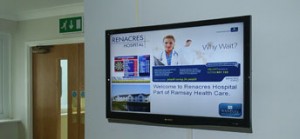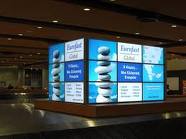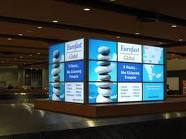ABB’s Blog
Brand Awareness with Digital Signage
Outdoor digital signage has been a boon for brands and generating brand awareness. For many companies building up brand awareness is an integral part of their marketing strategy – a brand is what separates one particular manufacturer or service provider from another. The brand could be the product name, business name, sign, symbol or slogan.
For many industry sectors, the brand is far more important than the product they are attempting to sell, with industries such as fashion and technology heavily reliant on brand identification. So, building up brand awareness is a vital part of ensuring a business, or brand, continues to prosper and to do this requires marketing of the brand to help people identify and begin to trust it.
Generating Brand Awareness
Some companies rely solely on their brand. Many of the sports fashion companies sell products because of their name, not because of the product, as do some famous technology companies that produce phones and tablets.
Advertising with Digital Signage
All manner of industry and trade can and do use Digital signage to attract attention to themselves. Take the classic case of the retail industry for example. They set up in-store digital media networks which enable customers to get exposure to targeted advertising, touch screen interface, product information programming, and so on.
These are times of fleeting attention spans where holding someone’s attention has become impossible. People hardly have time to watch television, much less the ads shown on them. Digital signage is a powerful alternative, where customized content across a variety of digital displays exposes the audience to a much more interactive and dynamic interface with the advertiser.
- An indoor digital signage advertising system works beautifully in areas of high footfalls, such as lobbies, parking centers, escalators, window displays and so on. Choosing the right location is of paramount importance here.
- Outdoor digital signage on the other hand is a wonderful opportunity to catch moving pedestrian and automobile traffic. Additionally it enables nighttime advertising. That apart the messaging can be changed on demand and in real time reflecting a current event or happening. Advertise breakfast foods in the morning and restaurants at night!
Food Industry and Digital Signage
In restaurants, the most common use of digital signage is in the menu boards. The menu boards are generally placed outside the premises, but there are also some fast food joints which keep these menu boards inside the set-up. There are various reasons as to why this technology is being profusely used in the food industry. The most important reason as to why touch screen signage is used is that the food items look a lot more attractive when displayed in the LCD screens.
For example, when food items are displayed in these screens, you can add to the effect of steam coming out from the food item. Such a technique is absolutely lip-smacking. Moreover, it is also possible for the customers to browse through the portals and find a food of their choice.
Besides giving an appealing look to the food items with digital signage, the customers can also have an idea as to how the food item looks like. It is also possible for them to have a glance at the prices of the various food items which are available in the food joint.
At this juncture, it can be said that if the touch screen signage is placed outside the eating joint, the customers have the option of checking out the prices before entering the joint and proceed further if the prices go well with their pockets.
Another benefit of using digital signage in the restaurants is that it has the ability to change the content as and when required. In other words, scheduling of the content according to the time of the day is done automatically in the signage technology. This proves to be a great boon for the food industry because the menu changes accordingly. For example, when it is lunch time, the food on offer is displayed and the customers might get attracted seeing the images. Moreover, the guests need not wait in a queue to place the order.
They can do so by keeping their fingers on the touch screen device. In short, the menu cards may get replaced soon by the digital menu, which would be more convenient for the customers.
Internal Communications in the Workplace
It is of vital importance to be able to communicate key information and time sensitive data to your employees and visitors.
- Communicate key information to employees and visitors from your corporate lobby and common areas
- Provide visitors with wayfinding maps and meeting locations
- Deliver welcome messages to important visitors and clients at the front desk
No More High Printing or Labor Costs
You will save on labor time, printing costs, and more when you upgrade your communication system to a digital advertising network from ABB Advertising.
- Keep employees informed about important announcements, such as changes in benefits
- Show calendars of upcoming company events
- Highlight corporate and individual accolades, such as the Employee of the Month
- Provide recognition to employees on their birthday or anniversary
- Broadcast training videos, safety procedures, and messages from management
- Display emergency alert messages
- Extend your content to break rooms, cafeterias and other common areas
Deliver Public Information with Digital Signage
 Digital Signage can easily be the solution for any organization that needs to get information into the hands and minds of their audience.
Digital Signage can easily be the solution for any organization that needs to get information into the hands and minds of their audience.
The public can use digital screen to:
- Find theaters, restaurants and areas of interest,
- See ads for local businesses,
- Reach city information or emergency services,
- Understand crucial information in the case of a city-wide emergency.
- airports,
- railway stations and
- bus terminals in order to provide passengers with clearer and quicker updated information.
- concourses,
- passenger waiting halls,
- reservation centers,
- hospitals,
- airport lobbies,
- and other such locations.
Digital Signage Arizona, Best Advertising in Arizona

Industry experts all agree that one of the main obstacles we face in the digital signage industry is gaining an understanding of the full scale and scope of what digital signage entails as well as what it can do for customers/end users and then conveying that message to the customer in a risk adjusted value proposition that is relevant to their project. It is the process of conveying and translating the message to the customer that the sales process often breaks down.
ABB Advertising focuses on sales specific information and the skills necessary to translate value into reality for the digital signage customer.
Most of us are too busy to become fully immersed in all areas. The problem we face is that the digital signage niche is too complex for elements to be glossed over and each one must be addressed at least in fundamental terms from a core knowledge perspective. ABB Advertising is the solution.
There is great parity in the industry relative to hardware and great solutions abound which is only part of the reason ABB Advertising exists. We bring the solution to you so you don’t have to go on the hunt for it.
Software selection is not an easy part of the equation. There are over 300 software vendors on the market of all types and varieties. Selecting the right one is critical and this will determine how easy the digital signage system is to use. ABB Advertising has once again taken the guess work out for you!
Of course we have all heard that “content is king” and in fact it is. No matter how solid the infrastructure and how good the software package might be, poor content will render the digital signage system ineffective at best or in the worst case totally useless. We cannot overstate the importance of content and we explore what makes up good content and take a look at specific examples.
Send us an email below or call the office and we will consult with you about an advertising solution in Arizona.
Digital Signage Responds to Its Audience

Digital signage as an advertising tool aims to convey ideas, leave impressions and persuade an audience to take actions. Informative messages, extraordinary visual images and sound effects are used to catch the audience’s attention. As new technologies emerge, digital signage providers are currently playing with the idea of audience interaction and assessing its commercial potential. Digital signage is increasingly integrated with interactive technology which can not only be used for advertising but also react to the trend of social, local and mobile (SoLoMo). Prevailing interactive technologies include anonymous video analysis, gesture recognition, touch screen, and smartphone integration.
Anonymous Video Analysis Seizes Power of Information
Digital signage capable of video analysis helps advertisers seize the power of information. While playing advertisements, digital signage can detect a viewer’s presence, count dwell time, complete a head count and gather other important demographic data, such as gender, age and ethnicity. Based on this information, an advertiser can tell whether the content displayed is compelling, what captures the viewer’s attention, which groups of viewers are attracted, whether the digital signage is installed in the correct location and help evaluate if digital signage is a good investment.
 Figure 1. As new technologies emerge, digital signage providers are currently playing with the idea of audience interaction and assessing its commercial potential.
Figure 1. As new technologies emerge, digital signage providers are currently playing with the idea of audience interaction and assessing its commercial potential.Before video analysis, evaluation of return on investment for digital signage was difficult to measure; this is because an advertiser could only gauge a viewer’s reaction by physically watching the person viewing the deployment. Therefore, interactive digital signage; which can gather data on audience behavior, is extremely beneficial to advertisers. In addition, digital signage with capability of video analysis can also help advertisers to deliver a better message to the right audience.
For example, a promotion targeting a teen audience should obviously be targeted at this particular audience. Once the advertisement is active, advertisers can run analysis to see whether the message is effective and has been viewed by the right audience. If not, advertisers can make amendments to the campaign content or signage location to improve overall effectiveness.
The collection of any form of data collection can raise issues regarding privacy. In response to these concerns, video analysis has moved towards anonymity to protect viewers who prefer to be invisible. Anonymous video analysis which collects data in real time for marketing analysis whilst allowing viewers to remain “off the radar” is the obvious way forward.
Gesture Control Lets Body Speak
While some digital signage software can perform video analysis, others allow viewers to communicate without physical contact. Digital signage equipped with cameras can capture body movements, which will be interpreted as command, and act on them.
For instance, American retailer Wal-Mart used interactive digital signage for a holiday sales promotion, which allowed the audience to choose selected products by waving their arms in the air. Thus to acquire detailed product information including retail price, product specifications and other key data, the audience would just have to point at the selected item. The virtue of a gesture-based interface is that the audience can interact with digital signage without having to make any form of physical contact. Gesture recognition is so convenient that even people with a handful of shopping bags can participate without putting down their belongings.
In addition, the camera and software is so advanced that it can be programmed to detect and recognize gestures of people that are several meters away from the screen. This feature allows advertisers to use larger screens with wider viewing angles to enhance the viewing experience.
Let the Fingers Do the Talking
Touch screen technology is another predominant method of interaction. Different from gesture recognition, touch interfaces require physical contact. It can precisely distinguish a viewer’s intention and leave positive impressions. MasterCard installed touch screen digital signage to promote its online shopping service. It allows viewers to browse various promotional offers and get bargains by entering an email address with the on-screen keyboard. This kind of promotional activity is not possible with gesture recognition systems.
In fact, gesture recognition may be affected by environmental factors. For instance, a gesture can be recognized differently under different illumination conditions. As a result, there is a chance digital signage could display undesired information and disappoint viewers. Therefore when highly accurate information is required touch interface can be useful and improve customer satisfaction.
Furthermore, touch command like online behaviors can be monitored and used to track what content the audience is interested in.
This information can also be analyzed to help advertisers plan marketing strategies in the future.
Smartphone, the Digital Signage in Your Pocket
It’s a well known fact that smartphone has distracted people from digital signage. Those who usually glance around, now have their eyes glued to a small phone screen. As consumer behavior changes, digital signage begins to integrate mobile technology to hold on to every opportunity to win public attention. Smartphone has a screen, wireless connectivity, camera, third party applications, and various features opening opportunities for more interaction for digital signage, too.
 Figure 2. Prevailing interactive digital signage technologies include anonymous video analysis, gesture recognition, touch screen, and smartphone integration.
Figure 2. Prevailing interactive digital signage technologies include anonymous video analysis, gesture recognition, touch screen, and smartphone integration.As a matter of fact, a smartphone can be regarded as extension of digital signage. Digital signage can send advertisements to viewers who can store information on their own mobile gadgets, carry the information around and access it whenever it is required.
For example retailers can deliver more detailed product information to smartphone via digital signage. Museums can provide floor plan and tour guides to visitors. Those who read information on smartphones essentially interact with digital signage.
With downloaded content, a smartphone essentially becomes a miniature digital signage player which can break time and space boundaries. In addition, with digital signage now moving onto smartphone advertisers can communicate with multiple viewers at the same time.
Smartphone integration also allows viewers to interact with digital signage in various ways. Mobile technologies which can be exploited also include QR codes, web browsers, short message service (SMS), near field communication (NFC), radio frequency identification (RFID) and Wi-Fi. For instance, the Discovery channel once erected digital signage in New York to promote a new TV Series called “Storm Chasers”. This digital signage campaign created the augmented reality of viewers blown off their feet by storms. Viewers could either text to a number to receive a link to the photo on Facebook or have photo sent via email.
Though digital signage can not initiate the connection, advertisers can provide incentives, such as exciting experiences, coupons and exclusive offers to encourage viewer engagement. For example, digital signage in the retail store can send product details alone with coupon to smartphone users. In the best-case scenario, it will tickle viewer’s fancy and awaken desire of purchase.
 Conclusion
Conclusion
Digital signage combines interactive elements like anonymous video analysis, gesture recognition, touch screen, and smartphone integration providing more information to both viewers and advertisers. It also stands for fun and satisfies individual needs for information. In comparison with conventional digital signage which only provides unilateral communication, interactive digital signage increases display effectiveness, enhances viewer experiences and has a better chance to leave impressions and to elicit purchase.
22 million digital signs by 2015

Getting a handle on the real size of the digital signage (DS) industry is a challenge. Most analysts focus on specific geographic areas or niche sectors, making it hard to get comparable data on a global basis. Another complication: in most markets, 80 percent of the digital signage integrators are local companies and often span the audio/visual and IT worlds.
The sizing challenge: When Intel first tried to construct a worldwide market model for digital signage in 2009, we utilized our best estimate of 2008 actuals and assumed a 26 percent compounded annual growth rate (CAGR): this led us to estimate 8 million media players and correspondingly 16 million digital signs by 2015. I first discussed this market model at the Digital Signage Expo (DSE) in early 2010 and over the following months many analysts converged on these numbers. However, in mid-2009, we felt (and most analysts agreed) that the digital signage market would actually grow at a 38-42 percent CAGR over the next few years. But, because digital signage was a new focus at Intel and our market model is used for factory loading and revenue commits, we decided to stay with the 26 percent CAGR. The take away that was widely reported was 8 million media players and 16 million digital signs by 2015.
Fast forward to 2011: We just updated our worldwide market model for digital signage again, taking a local approach and building up to a global model. This time we made a significant effort to estimate the numbers by country and vertical sector. It wasn’t surprising that 2010 actuals exceeded our previous model by some 60 percent because, indeed, the industry had been growing at about a 40 percent CAGR. Now most analysts are predicting a 35 percent CAGR going forward for the next few years.
So what is the latest prediction?
Utilizing 2010 actuals and a still conservative CAGR of 26 percent, Intel’s revised model now predicts 10 million media players and a corresponding 22 million digital signs by 2015. It is clear that the digital signage market is expanding at a significant pace.
Worldwide, the top three sectors will continue to be retail, corporate and transportation, but other sectors such as healthcare and hospitality are seeing significant growth as well. The development of transportation networks, public infrastructure and new commercial buildings, particularly in developing countries such as India, China and Singapore, are all creating more opportunity to target the core audiences of corporate workers, commuters and retail shoppers.
Retail is king in most regions, with the exception of the People’s Republic of China, where transportation tops the market. Corporate is big in EMEA but still follows retail. Healthcare and hospitality have seen tremendous growth in North America. All of these verticals boast a targeted audience base and high dwell times and, although we don’t collect this data specifically, stable advertising CPMs. In a nutshell: digital signage continues to grow because its leading sectors are demonstrating a proven ability to deliver audiences. I don’t think that’s going to change.
While the audiences are clearly there for digital signage, that alone doesn’t explain such strong growth rates. Here are two observations as to why the growth is so strong. These are by no means the only factors, but they are among the most important:
1.) Digital signage is proving itself in a fragmented media market. The strengths of digital signage are becoming more evident as the inherent weaknesses in more traditional media forms become more pronounced. Digital signage has demonstrated a continuing ability to reach large audiences in a targeted way at a point where it really matters: at the point of sale or, at a very minimum, when consumers can easily alter their travel plans to go to a point of sale (e.g., a pet owner watching digital signage at a vet’s office). Other media — newspapers, magazines, TV — do not have the strength of place or the flexibility to deliver such targeted messages to specific audiences. Add to this, a growing sophistication in how brands want to manage the consumer experience. Brands want to deliver interactive, personalized and enjoyable experiences to end-customers wherever they are located, on whatever device they are using or seeing or interacting with. DS is a critical medium for making this happen. Additionally, a proven, experienced ecosystem of digital signage system integrators is emerging. This is critical to any technology market and digital signage is no exception. Digital signage system integrators have emerged as an engine of growth, particularly in meeting the need for turnkey solutions for the SMB market. In fact, many system integrators have doubled their revenues year over year for the last couple of years.
2.) The increased performance and cost-effectiveness of digital signage. As digital signage systems have evolved, they have inevitably become more cost effective, lowering total cost of ownership. The initial costs of planning and setting up a digital signage infrastructure have dropped, removing or at least lessening a significant barrier to growth. Today’s solutions support remote manageability, energy efficiency and enough performance for advanced capabilities such as anonymous video analytics (for audience metrics and enhanced ROIs), and the ability to process and blend rich media content. Advertisers are recognizing the flexibility and cost-effectiveness digital signage can provide compared to traditional media, i.e., content can be changed remotely; customers can be targeted more accurately.
Arguably, no other marketing media can match the value proposition that digital signage delivers: the ability to reach a mass audience with such a high level of flexibility in creative, placement, cost and (with the addition of audience metrics) proven performance. As the market data are already showing, that value proposition is a winning one.



